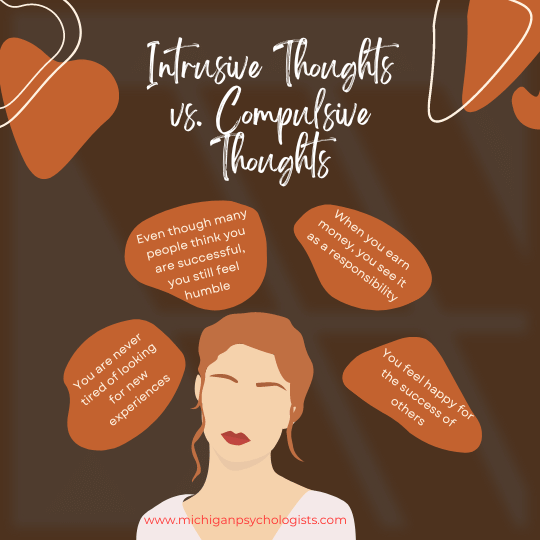
Table of Contents
Imagine your mind as a vast, serene landscape, a place where your thoughts flow like a gentle stream. But then, out of nowhere, an unwanted thought disrupts this tranquility, creating ripples that disturb your peace. This scenario is all too familiar for many people who experience intrusive and compulsive thoughts. These thoughts can be puzzling, distressing, and overwhelming, yet they are a common experience in the human psyche. Today, we delve into the nature of these mental intruders, exploring what they are, how they compare, how they differ, and most importantly, how to manage them effectively. Let’s embark on this journey to better understand our minds and regain our peace.
What Are Intrusive Thoughts and Compulsive Thoughts?
Intrusive Thoughts are involuntary, unwanted thoughts that appear suddenly and can be distressing. They often involve disturbing themes such as violence, taboo subjects, or catastrophic events. Despite their unsettling nature, these thoughts do not reflect a person’s true desires or intentions.
Compulsive Thoughts, on the other hand, are repetitive, anxiety-driven thoughts that compel an individual to perform certain behaviors or mental acts to alleviate distress. These thoughts are often associated with Obsessive-Compulsive Disorder (OCD) and can lead to compulsive behaviors such as checking, counting, or washing.
How Are Intrusive and Compulsive Thoughts Similar?
Both intrusive and compulsive thoughts share the characteristic of being unwanted and distressing. They invade the mind, often causing significant anxiety and discomfort. Additionally, individuals experiencing these thoughts may struggle with feelings of shame or guilt, mistakenly believing that the presence of such thoughts indicates something negative about their character. In both cases, the thoughts can be persistent and difficult to ignore, leading to considerable distress.
How Are Intrusive and Compulsive Thoughts Different?
The primary difference between intrusive and compulsive thoughts lies in their nature and the individual’s response to them.
Nature of the Thoughts: Intrusive thoughts are random and do not typically lead to any specific behavior. They are like mental intruders that pop up without any clear trigger. Compulsive thoughts, however, are usually linked to a specific fear or anxiety, driving the individual to engage in compulsive behaviors to reduce the associated distress.
Response to the Thoughts: When experiencing intrusive thoughts, individuals may feel disturbed but do not necessarily feel compelled to act on them. In contrast, compulsive thoughts create a sense of urgency, pushing individuals to perform certain rituals or actions to alleviate their anxiety.
Proven Solutions to Manage Intrusive and Compulsive Thoughts
1. Cognitive Behavioral Therapy (CBT)
Why it Works: CBT helps individuals identify and challenge irrational thoughts, reducing their power. For both intrusive and compulsive thoughts, CBT provides tools to reframe and manage distressing thoughts effectively.
2. Exposure and Response Prevention (ERP)
Why it Works: ERP is a form of CBT specifically effective for OCD and compulsive thoughts. It involves exposing individuals to the source of their anxiety without allowing them to perform the compulsive behavior, gradually reducing the distress associated with the thoughts.
3. Mindfulness Meditation
Why it Works: Mindfulness helps individuals observe their thoughts without judgment, reducing the emotional impact of intrusive thoughts. By practicing mindfulness, individuals can learn to let go of unwanted thoughts more easily.
4. Medication
Why it Works: Selective Serotonin Reuptake Inhibitors (SSRIs) and other medications can help regulate the brain’s chemistry, reducing the frequency and intensity of both intrusive and compulsive thoughts. Medication can be particularly effective when combined with therapy.
5. Stress Management Techniques
Why it Works: High stress levels can exacerbate intrusive and compulsive thoughts. Techniques such as regular exercise, adequate sleep, and relaxation exercises can help manage stress and reduce the occurrence of these thoughts.
6. Journaling
Why it Works: Writing down thoughts can help externalize and process them, reducing their impact. For both intrusive and compulsive thoughts, journaling provides a safe outlet to explore and understand these thoughts better.
7. Seeking Support Groups
Why it Works: Connecting with others who experience similar challenges can provide validation and support. Support groups offer a sense of community and shared understanding, which can be incredibly comforting.
8. Limiting Stimulants
Why it Works: Caffeine and other stimulants can increase anxiety and agitation, worsening intrusive and compulsive thoughts. Reducing stimulant intake can help maintain a calmer mind.
9. Establishing a Routine
Why it Works: A structured daily routine can provide predictability and control, reducing anxiety and the frequency of distressing thoughts. Consistency helps create a stable environment where the mind feels safer and less prone to anxiety.
10. Testing for Underlying Conditions
Why it Works: Identifying and treating underlying conditions, such as ADHD or OCD, can provide targeted strategies and treatments to manage intrusive and compulsive thoughts more effectively. Proper diagnosis is crucial for effective treatment.
Where to Get Help for Intrusive and Compulsive Thoughts
If you or someone you know is struggling with intrusive or compulsive thoughts, seeking professional help is crucial. Here are some resources:
- Psychologists and Psychiatrists: Licensed mental health professionals can provide therapy and prescribe medication.
- Cognitive Behavioral Therapists: Specialists in CBT and ERP can offer targeted treatment for intrusive and compulsive thoughts.
- Support Groups: Organizations like the International OCD Foundation offer resources and support groups for individuals experiencing OCD and related disorders.
- Online Therapy Platforms: Services like BetterHelp and Talkspace provide convenient access to professional therapy.
Intrusive and compulsive thoughts can feel like relentless invaders in the mind, but understanding their nature and how to manage them is the first step toward reclaiming your mental peace. By employing effective strategies and seeking appropriate help, you can navigate these thoughts and reduce their impact on your life. Remember, the presence of these thoughts does not define you—they are just part of the complex tapestry of the human mind. Embrace the journey toward understanding and managing your thoughts, and you’ll find greater peace and resilience along the way.